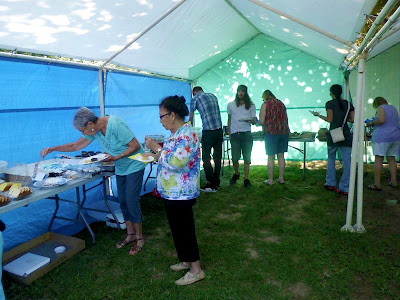Cilantro. It's difficult to describe the flavor, but it certainly packs a whollop and brings any food or dish up a notch. When I was first growing/eating fresh herbs, I could hardly handle it's fresh, pungent, slightly lemon aroma. I remember planting patches of it in my enthusiasm for growing herbs. I never used it, but growing it for years finally allowed the plant flavor to "grow" on me until now, I absolutely love it! But Cilantro (also known as Coriander), is a little tricky to grow. It likes cooler weather and tends to bolt and go to seed (here is where the coriander comes in) in hot temps. In other words, like lettuce, it grows and goes. So, you have to take care and keep it harvested regularly in order to get any use out of it and replant it frequently.
This year, even though it was a very hot summer, I am growing my third planting. I have been using pots because in this extreme heat, I am able to move Cilantro into a shaded area to grow. It has done extremely well in the shade (late afternoon sun for a few hours) and I have kept it much longer than if it had been growing in the garden.
I use two pots for this. I have starts in one and when it matures enough for a picking, I start the second pot. Once the Cilantro goes to seed (about the third picking), I pull out the old plants, freshen the soil with a little new dirt and organic fertilizer and put in more seeds. Sometimes after the season is done. I let the mature plants go to seed and let the seedheads stay in the pot. This has given me a fresh start the next spring. Always a great bonus to get free plants!
So, make successive plantings, and use pots to keep it in the shade during the heat of summer. It also makes it much easier to grab a small amount when it's only in a pot outside the door. I have found the amount I've been growing is enough for our table use as Cilantro doesn't dry well at all.
 |
| New pot of baby Cilantro next to its full grown predecessors... |
A very easy and delicious herb to grow and keep when given the right conditions. I absolutely love it in "Cilantro-Lime Rice." I use a huge handful minced up in the rice along with the juice of one or two limes. It is a huge flavor enhancer without relying on salt.
What's your favorite Cilantro recipe? Blessings!!
Linked to these blog hops: Frugal Days, Sustainable Ways , Lisa Leonard Online: Hello Mondays , The Prairie Homestead Barn Hop , Living Green Tuesdays
OffTheGridat-30

















































